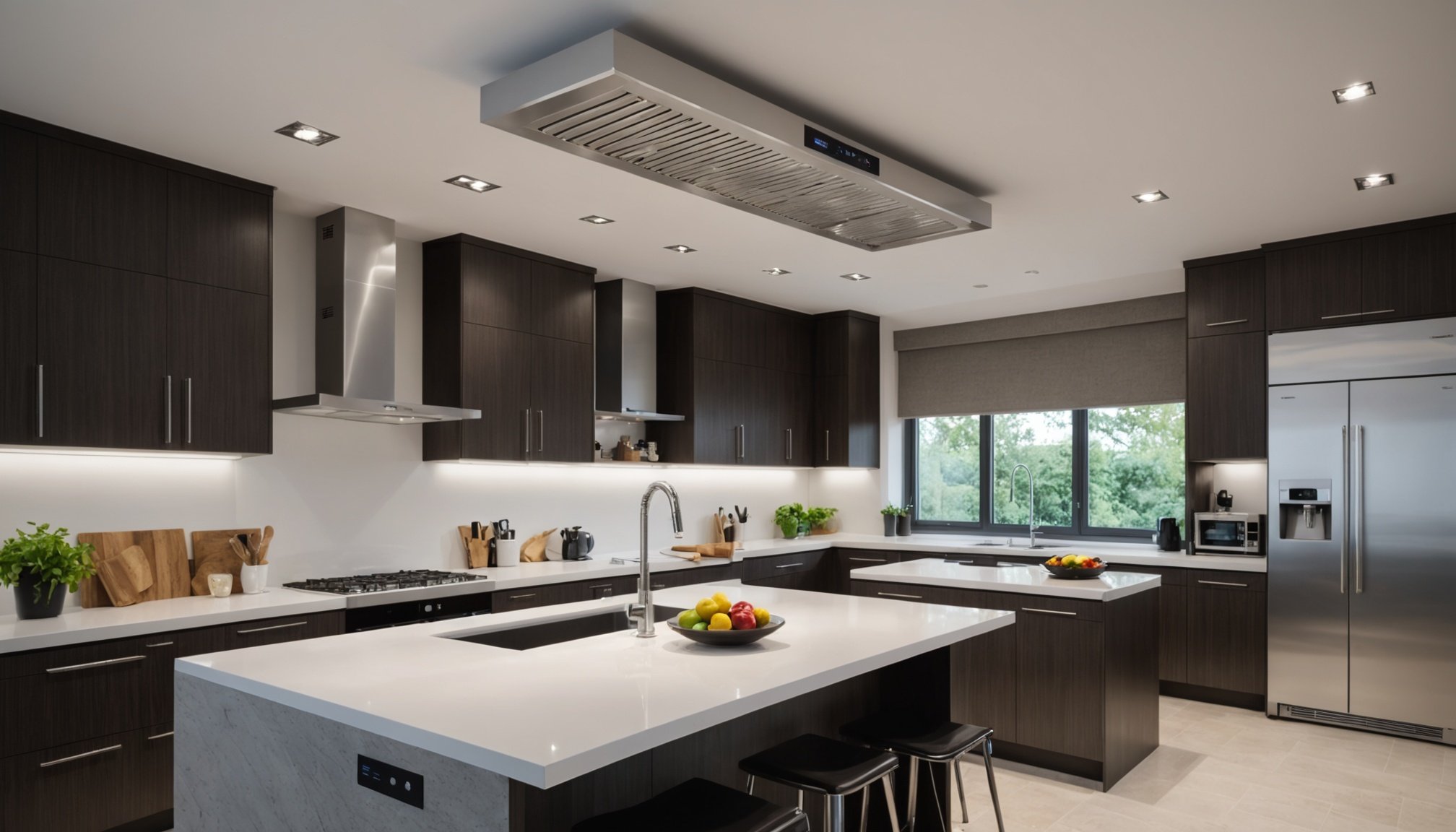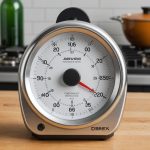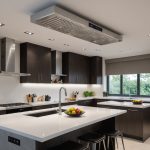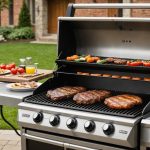Ultimate Guide to Installing an Exceptional Kitchen Ventilation System for Your UK Home
Why Kitchen Ventilation is Crucial
When it comes to maintaining a comfortable, healthy, and odor-free kitchen, ventilation is paramount. Poor ventilation can lead to a multitude of issues, including the growth of mould and mildew, unpleasant cooking odours lingering in the air, and even health problems due to poor air quality. Here’s why investing in a good kitchen ventilation system is essential for your home.
“Kitchen ventilation is not just about removing cooking odours; it’s about maintaining good indoor air quality (IAQ) and preventing moisture buildup,” explains Natasha King from Vent-Axia. “This is especially important in smaller or enclosed kitchens where moisture can quickly become a problem”[1].
In the same genre : Comprehensive guide to selecting ideal kitchen island lighting for your home in the uk
Types of Kitchen Ventilation Systems
There are several types of ventilation systems you can install in your kitchen, each with its own set of benefits and considerations.
Cooker Hoods
Cooker hoods are one of the most common and effective ways to ventilate your kitchen. They are installed above your hob and capture steam, odours, and grease particles before they can disperse into the air.
Also read : Unlock culinary precision: the ultimate guide to selecting the ideal kitchen timer in the uk
- Ductless vs. Extraction Hoods: Ductless hoods, also known as recirculating hoods, draw in air, clean it using a grease filter and active carbon filter, and then release the cleaned air back into the kitchen. Extraction hoods, on the other hand, draw in air and pipe it straight to an extraction point outside your home[4].
- Installation Height: The installation height of your cooker hood depends on the type of hob you have. For electric hobs, the hood should be installed around 45 to 64cm above the cooktop, while gas hobs require a slightly higher clearance of at least 65cm[4].
Extractor Fans
Extractor fans are another vital component of kitchen ventilation. They can be used in conjunction with cooker hoods or as a standalone solution.
- Intermittent vs. Continuous Fans: Intermittent extractor fans run on demand and are often used with background ventilation (such as trickle vents in windows). Continuous fans run at a low speed and boost when needed, providing consistent ventilation and helping to reduce pollutants and moisture[1].
- Installation Requirements: According to UK building regulations, if you have a cooker hood that extracts to the outside at 30l/s, there is no need for additional extract ventilation. However, if there is no cooker hood or if the cooker hood does not extract to the outside, an intermittent extractor fan needs to run at 60l/s[1].
Choosing the Right Ventilation System for Your Kitchen
Selecting the right ventilation system involves several considerations, including the size of your kitchen, the type of cooking you do, and your personal preferences.
Matching Your Cooker Hood to Your Stove
“Choose a matching range hood with the right dimensions, style, and power to match your stove,” advises Debra Hutt. “It should cover the cooktop completely. Gas stoves often require a more powerful hood compared to electric ones”[1].
Here are some key points to consider when choosing a cooker hood:
- Size: The cooker hood must be at least as wide as your hob to effectively remove cooking odours[4].
- Type: Decide between ductless and extraction hoods based on your kitchen layout and ventilation needs[4].
- Features: Look for innovative features such as self-regulating fan speed, hob-hood control, and different types of filters (grease and odour filters)[4].
Additional Extraction Fans
In addition to a cooker hood, installing a secondary extraction fan can enhance overall air quality in your kitchen.
- Placement: Install the fan in a strategic location to ensure it can filter the air throughout the room[1].
- Usage: Use the fan consistently, even when you’re not actively cooking, to maintain good air quality[1].
Compliance with Building Regulations
Ensuring your kitchen ventilation system complies with UK building regulations is crucial for both safety and efficiency.
Part F of the Building Regulations
“New build properties and retrofit projects where energy efficiency measures are implemented should all have kitchen ventilation installed in line with the Building Regulations,” explains Natasha King. “An assessment may be needed to determine what additional ventilation is required based on the estimated impact of the work”[1].
Here are some key regulatory points to consider:
- Ventilation Requirements: There is no strict legal requirement to have an extractor fan, but some form of ventilation is mandatory. Opening a window can also serve as a simple form of ventilation[1].
- Energy Efficiency: Ensure that internal doors allow airflow through the dwelling by providing a minimum free area equivalent to a 10mm undercut in a 760mm wide door[1].
Installation Costs and Considerations
Installing a kitchen ventilation system can vary in cost depending on several factors, including the type of system, the complexity of the installation, and whether you are doing a self-build or hiring professionals.
Labour Costs
The labour cost for installing kitchen units and ventilation systems can range significantly. Here are some general estimates:
- Kitchen Fitting Labour: Labour costs for fitting a kitchen can range from £1,500 to £5,000, depending on the kitchen’s size and complexity[3].
- Ventilation System Installation: The cost of installing a ventilation system can be included in the overall kitchen fitting cost or can be a separate expense, depending on the complexity of the installation.
Material and Equipment Costs
Here is a breakdown of some of the costs associated with different components of a kitchen ventilation system:
| Component | Cost Range |
|---|---|
| Cooker Hood | £200 – £1,000 |
| Extractor Fan | £50 – £200 |
| Ducting and Fittings | £50 – £200 |
| Filters and Accessories | £20 – £100 |
| Labour for Installation | £100 – £500 |
DIY vs. Professional Installation
While some homeowners might opt for a DIY installation to save costs, hiring a professional can ensure compliance with building regulations and optimal performance of the ventilation system.
- DIY Installation: If you decide to install the system yourself, ensure you follow all safety guidelines and building regulations. For example, installing a cooker hood under an 8′ ceiling can be challenging and may require creative solutions[2].
- Professional Installation: Hiring a professional ensures that the job is done correctly and efficiently. They can also provide advice on the best system for your specific needs and ensure that all installations meet safety standards[3].
Practical Tips for Effective Kitchen Ventilation
Here are some practical tips to help you achieve the best ventilation in your kitchen:
Regular Maintenance
- Clean Filters: Regularly clean or replace the filters in your cooker hood and extractor fans to ensure they work efficiently[4].
- Check Ducting: Ensure that the ducting is clear and not blocked to maintain proper airflow[1].
Optimize Airflow
- Internal Doors: Ensure internal doors allow airflow through the dwelling by providing a minimum free area equivalent to a 10mm undercut in a 760mm wide door[1].
- Windows and Vents: Use windows and trickle vents to provide additional background ventilation[1].
Energy Efficiency
- MVHR Systems: Consider installing Mechanical Ventilation with Heat Recovery (MVHR) systems, which can provide fresh air while recovering heat from the extracted air, making them energy efficient[1].
- Energy-Efficient Fans: Choose fans with low energy consumption and high efficiency to reduce your energy bills[5].
Installing an exceptional kitchen ventilation system is a critical aspect of maintaining a healthy, comfortable, and odor-free kitchen. By understanding the different types of ventilation systems, ensuring compliance with building regulations, and considering practical tips for maintenance and optimization, you can create a kitchen that not only looks great but also functions perfectly.
Remember, “the right kitchen ventilation will remove moisture, stop condensation, and keep your home smelling sweet,” as Warren from Homebuilding.co.uk emphasizes. With the right system in place, you can enjoy a kitchen that is not only functional but also a pleasure to be in[1].
Additional Resources
For further guidance, here are some additional resources you might find helpful:
- Vent-Axia: Offers a range of ventilation solutions and expert advice on kitchen ventilation[1].
- Bosch Home: Provides detailed guides on choosing and installing the right cooker hood for your kitchen[4].
- AceKitchen: Offers comprehensive guides on kitchen fitting costs and compliance with building regulations[3].
By following this ultimate guide, you can ensure that your kitchen ventilation system is not only effective but also compliant with all the necessary regulations, making your kitchen a healthier and more pleasant space for you and your family.











